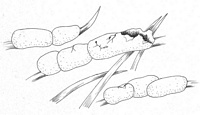|
 Diderma alpinum Diderma alpinum
SynonymsDiderma globosum var. alpinum
BiostatusPresent in region - Indigenous. Non endemic
Images (click to enlarge)
Caption: Sporangia of Diderma alpinum fruiting on grass litter. Several of the sporangia are somewhat elongated and thus plasmodiocarpous. Each sporangium is about 1 mm in diameter.
Owner: S.L. Stephenson |
Article: Stephenson, S.L. (2003). Myxomycetes of New Zealand. Fungi of New Zealand. Ngā Harore o Aotearoa 3: xiv + 238 p. Hong Kong: Fungal Diversity Press.
Description: Fruiting body a sessile sporangium (but often elongated into a short plasmodiocarp), crowded, pulvinate, 0.7–1.0 mm in diameter. Hypothallus conspicuous, white, calcareous, mostly under sporangia, sometimes containing large, subcrystalline lime nodules. Peridium consisting of two layers, the layers distant or readily separating, outer layer white, calcareous, crustose, smooth, inner layer membranous, shining, translucent, pale flesh coloured, dehiscence more or less irregular. Columella pulvinate, ochraceous-orange. Capillitium consisting of branched and anastomosing threads, these purplish or hyaline, bearing dark fusiform swellings, conspicuous or sparse. Spores black in mass, purplish brown by transmitted light, distinctly and somewhat irregularly spiny, 11–12 µm in diameter. Plasmodium white.
Habitat: Dead (or sometimes living) herbaceous stems and other types of plant debris, usually near melting snowbanks in alpine regions
Distribution: Recorded from Asia, Europe, and North America (Martin & Alexopoulos 1969, Yamamota 1998, Ing 1999). First reported from New Zealand by Stagg (1982), based on specimens collected in Taupo, Westland, and North Canterbury. Also known from South Canterbury and Mackenzie.
Notes: This species is perhaps the most commonly encountered member of the group of "snowbank" myxomycetes found in alpine regions of the Southern Alps (Stephenson & Johnston 2003). It is very similar morphologically to Diderma niveum, which occurs in the same ecological situations.
|